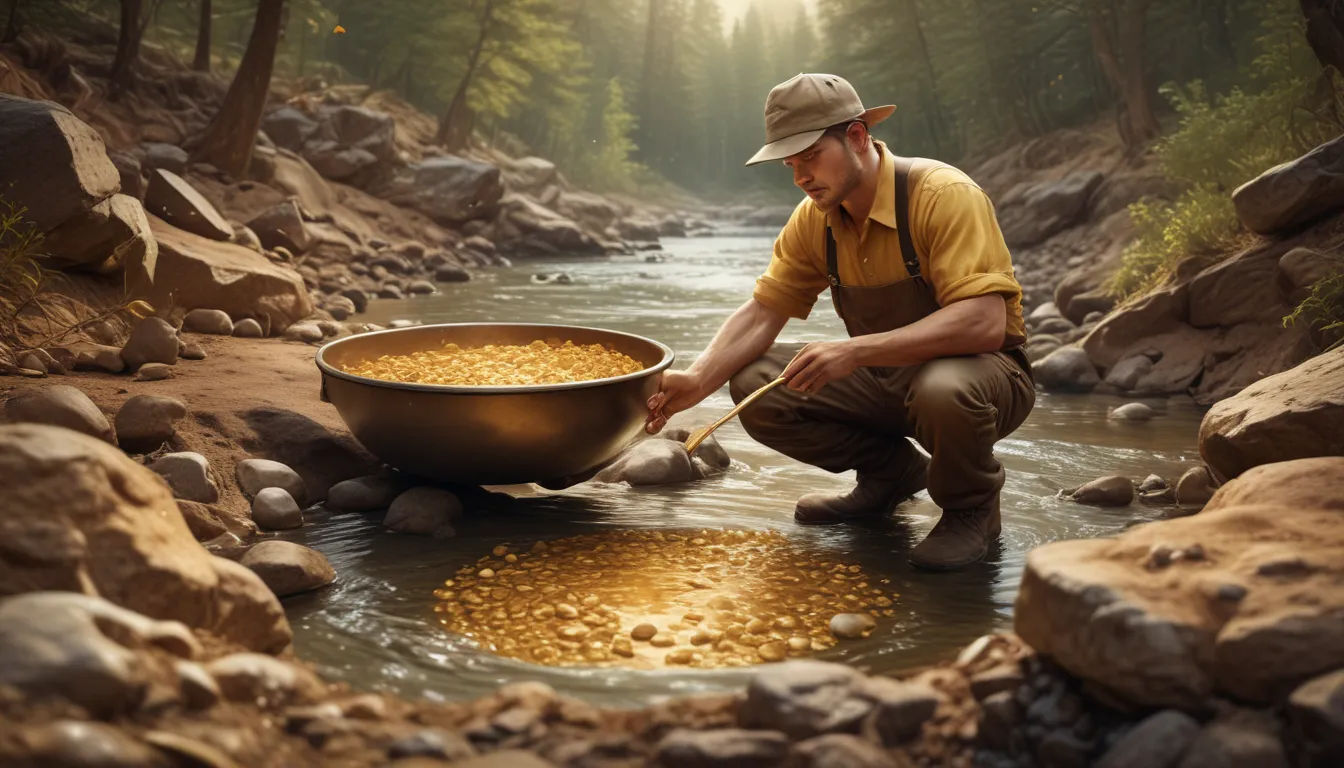A Note About Images: The images used in our articles are for illustration purposes only and may not exactly match the content. They are meant to engage readers, but the text should be relied upon for accurate information.
Gold panning is a timeless practice that has captivated the hearts of history enthusiasts, nature lovers, and adventure seekers for centuries. From its origins to its modern-day allure, the art of gold panning offers a unique connection to the natural world and the rich history of gold mining. In this article, we will delve into 19 fascinating facts about gold panning, exploring its intricacies and appeal. So, grab your pan, put on your boots, and let’s uncover the captivating world of gold panning together.
Unveiling the Origins of Gold Panning
Gold panning, an ancient method of finding gold in rivers and streams, predates the California Gold Rush and has been practiced for centuries. The California Gold Rush in 1848 popularized gold panning as a primary method of obtaining gold, sparking a wave of prospectors flocking to California in search of their fortune. The allure of gold panning lies not only in its potential for discovering gold but also in its historical significance and the thrill of the hunt.
The Basics of Gold Panning
Gold panning is a recreational activity that can be enjoyed by families and individuals alike. All it requires is basic equipment such as a pan, water, and sediment that may contain gold. The process involves careful swirling and washing of sediment in the pan, allowing the heavier gold particles to settle at the bottom while lighter materials are washed away. Gold panning locations are often near rivers and streams where gold tends to concentrate, making these areas prime spots for prospecting.
Environmental Impact of Gold Panning
When practiced responsibly, gold panning can be environmentally friendly, with minimal impact on the ecosystem. In fact, it can even serve as a way to clean up riverbeds by removing small amounts of pollutants. Gold panning competitions are held worldwide, where enthusiasts gather to showcase their skills and compete for prizes in events that test speed, accuracy, and the amount of gold recovered.
The Klondike Gold Rush and Beyond
Gold panning played a significant role in the settlement of the American West and was a central theme in the lore of the Wild West. The Klondike Gold Rush in Canada in the late 19th century drew thousands of prospectors hoping to strike it rich through gold panning. This historical event underscored the enduring appeal of gold panning as a pursuit of dreams and opportunity.
The Thrill of Gold Panning
Gold panning requires patience and attention to detail, as successful panners must carefully observe sediments and water to spot the glint of gold among other materials. Many families enjoy gold panning together, providing an opportunity to teach children about geology, history, and the excitement of discovery. While seeking gold, panners may also discover other valuable minerals such as garnets, platinum, or diamonds, adding to the thrill of the hunt.
Modern Innovations in Gold Panning
The art of gold panning has inspired the creation of specialized equipment, ranging from sluice boxes to suction dredges, to aid in the process. Despite advances in technology, many individuals still practice the art of gold panning, keeping alive a tradition that dates back to ancient times. Gold panning remains a popular tourist activity in many gold-bearing regions, offering visitors an opportunity to experience the local history and culture firsthand.
A Symbol of Hope and Opportunity
Gold panning continues to be a symbol of hope and opportunity, representing the pursuit of dreams and the possibility of finding wealth in unexpected places. This enduring appeal of gold panning captures the imagination of people around the world, drawing them into the exciting world of prospecting. Whether you’re a seasoned prospector or a curious beginner, the allure of finding gold in its natural form is an experience like no other.
Conclusion: Embrace the Adventure of Gold Panning
In conclusion, gold panning is a timeless and rewarding activity that offers a glimpse into the exciting world of prospecting. With its rich history and continued popularity, gold panning provides both a recreational pastime and a potential source of valuable treasure. As we’ve explored these 19 gold panning facts, it’s clear that this pursuit combines adventure, skill, and a deep connection to nature. So, grab your pan, head to the nearest river, and immerse yourself in the captivating art of gold panning!
FAQs: Answering Your Gold Panning Questions
What equipment do I need for gold panning?
To get started with gold panning, you’ll need a gold pan, a classifier, a shovel, and a vial to store your findings. Optional equipment includes a snuffer bottle, a magnifying glass, and a crevice tool for extracting gold from hard-to-reach spots.
Where is the best place to go gold panning?
The best locations for gold panning are typically areas with a history of gold production, such as rivers, streams, and old mining areas. Researching and obtaining permission to access these sites is essential, and joining a local gold prospecting club can provide valuable insights into prime panning locations.
Is gold panning a profitable activity?
While gold panning can yield valuable finds, it’s primarily enjoyed as a recreational pursuit rather than a reliable source of income. Many enthusiasts view the thrill of discovery and the connection to nature as the most rewarding aspects of gold panning.
Your Gold Panning Journey Begins Here
Our commitment to providing engaging and trustworthy content ensures that each fact on our site is contributed by real users like you, bringing a diverse range of insights and information. Trust in our dedication to quality and authenticity as you embark on your gold panning journey. Immerse yourself in the thrill of the hunt, the beauty of nature, and the allure of discovering treasure in unexpected places. Happy panning!






